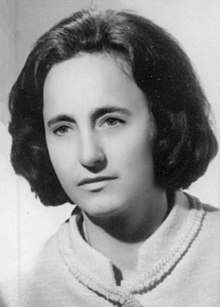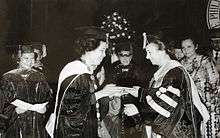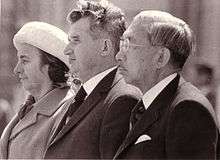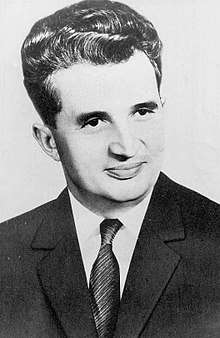Elena Ceaușescu
Elena Ceaușescu (Romanian pronunciation: [eˈlena t͡ʃe̯auˈʃesku]; née Lenuța Petrescu; 7 January 1916[2] – 25 December 1989) was a Romanian communist politician who was the wife of Nicolae Ceaușescu, General Secretary of the Romanian Communist Party and leader of the Socialist Republic of Romania. She was also the Deputy Prime Minister of Romania.
Elena Ceaușescu | |
|---|---|
 | |
| First Vice President of the Council of Ministers | |
| In office 29 March 1980 – 22 December 1989 | |
| President | Nicolae Ceaușescu |
| Prime Minister | Ilie Verdeț Constantin Dăscălescu |
| Preceded by | Gheorghe Oprea |
| First Lady of Romania[1] | |
| In role 22 March 1965 – 22 December 1989 | |
| General Secretary | Nicolae Ceaușescu |
| Succeeded by | Nina Iliescu |
| Personal details | |
| Born | Lenuța Petrescu 7 January 1916 Petrești, Romania |
| Died | 25 December 1989 (aged 73) Târgoviște, Romania |
| Cause of death | Execution by firing squad |
| Resting place | Ghencea Cemetery |
| Political party | Romanian Communist Party |
| Spouse(s) | |
| Children | Valentin Zoia Nicu |
Background
She was born Lenuța Petrescu into a peasant family in Petrești commune, Dâmbovița County, in the historical region of Wallachia. Her father worked as a ploughman. She was able to acquire only an elementary school level education. After elementary school, she moved along with her brother to Bucharest, where she worked as a laboratory assistant before finding employment in a textile factory. She joined the Bucharest branch of the Romanian Communist Party in 1939 and met 21-year-old Nicolae Ceaușescu. Ceaușescu was instantly attracted to her which, reportedly, made him never look at another woman in a romantic manner.[3] Their relationship was interrupted by Ceaușescu's frequent stints in prison, but they finally married on 23 December 1947.
Career in government

After the Communists took power, Elena Ceaușescu worked as a secretary in the Ministry of Foreign Affairs and was an unimportant figure until her husband became Communist Party General Secretary. Starting in July 1972, Elena Ceaușescu was given various offices at senior levels in the Romanian Communist Party. In June 1973 she became a member of the Politburo of the Romanian Communist Party, becoming the second most important and influential person after Ceauşescu himself. She was deeply involved in party administration alongside her husband, and was one of the few spouses of a Communist Party leader to have a high political profile of her own.
Elena Ceaușescu frequently accompanied her husband on official visits abroad. During a state visit to the People's Republic of China in June 1971, she took note of how Jiang Qing, Chairman Mao Zedong's wife, maintained a position of real power. Most likely inspired by this, she began to engineer her own political rise in Romania. In July 1971, after a mini-cultural revolution launched by her husband, she was elected a member of the Central Commission on Socio-Economic Forecasting, and in July 1972, she became a full member of the Romanian Communist Party Central Committee. In June 1973, after having been nominated by Emil Bodnăraș, she was elected to the party's Executive Committee. In November 1974, at the 11th Party Congress, she was made a member of the (renamed) political executive committee, and in January 1977, she became a member of the highest party body, the Permanent Bureau of the Political Executive Committee. In March 1975, she was elected to the Great National Assembly, the country's national legislature, holding the seat for Pitești, Arges County, the most important industrial region of the country, until her death in 1989. In March 1980, she was made a First Deputy Prime Minister, a state title she also held until she was executed in the Romanian Revolution.[4]

From the early 1980s onward, Elena was the object of a personality cult as intense as that of her husband, which exalted her as the "Mother of the Nation". By all accounts, her vanity and desire for honours exceeded that of her husband. As with her husband, Romanian Television was under strict orders to take great care portraying her on screen. For instance, she was never supposed to be shown in profile because of her large nose and overall homely appearance.[3]
Fall from power
Ceaușescu fled with her husband on 22 December 1989, after the events in Timișoara led to the Romanian Revolution, but she and her husband were captured in the town of Târgoviște. At the show trial that took place, she answered only a few questions since her husband took a protective role, asked her to calm down and shook his head each time her mouth opened to reply in anger.
Execution
On the afternoon of 25 December 1989 (Christmas Day) in Târgoviște, they were turned over to a firing squad and executed. Her arms, and those of her husband, were tied behind their backs. Popular history author Simon Sebag Montefiore has claimed that, before the sentences were carried out, Elena reacted far more belligerently than her husband, allegedly screaming: "You motherfucking assholes!" while being led up against the wall; at the same time Nicolae Ceaușescu sang "The Internationale".[5] Their actual execution was not filmed in time – the firing squad was in a hurry to carry out the sentence – but the aftermath, including echoes of the final volley, the pall of smoke, and the bodies immediately afterwards, were caught on camera. She was 73 years old.[6][7][8][9][10] She was the only woman ever executed by the modern state of Romania.[11]
Ceaușescu was outlived by her mother, a near centenarian at the time of her death, her brother Gheorghe Petrescu (also an important figure in the party) and her three children: Valentin (b. 1948), Zoia (1949–2006) and Nicu (1951–1996), who was also a very important member of the Romanian Communist Party. Elena Ceaușescu was buried in Ghencea Cemetery.
Reputation as a chemistry researcher
After graduating from primary school in her village and moving to Bucharest, Ceaușescu attempted to continue her education through night courses, but was allegedly expelled after being caught cheating. During the communist period she was promoted as a scientist, and was also awarded a PhD in chemistry.[12]
In 1957 she was a research scientist at ICECHIM (National Institute for Chemical Research). In the early 1960s she was reported to be secretary of the party committee of the Bucharest Central Institute of Chemical Researches, and, when her husband took over the party leadership in March 1965, she was listed as the institute's director. In December of the same year, she was elected a member of the newly established National Council of Scientific Research, and in September 1966 she was awarded the Order of Scientific Merit First Class.[13] In March 1974, she was made a member of the Romanian Academy's Section for Chemical Sciences. Ceaușescu was given many honorary awards for scientific achievement in the field of polymer chemistry during the period when her husband ruled Romania. She is named as co-inventor on a number of patents.[14]
After the Revolutions of 1989, several scientists have claimed that Ceaușescu had forced them to write papers in her name.[3][15] Claims have also arisen that the university gave her the honour of the doctorate solely because of her political position.
According to a 1984 report by Radio Free Europe, "It is rumored that, at the time when she wanted to receive her doctorate from the Bucharest Faculty of Chemistry, she met with strong opposition from the Romanian chemist Costin D. Nenitescu, the dean of the faculty. She was forced instead to present her thesis to Cristofor Simionescu and Ioan Ursu at the University of Iasi, where she met with complete success."[16]
In summary, to quote from an article on plagiarism in the leading scientific journal Nature:
...Elena Ceauşescu did not have a BSc, but the power of her husband Nicolae – Romania's dictator until communism fell – still made sure that the University of Bucharest awarded her a PhD in chemistry. The contents of her many scientific papers were penned by others.[17]
She was sometimes nicknamed "Codoi", referring to her alleged mispronunciation of the name of the chemical compound CO2 (C for carbon, O for oxygen, and "doi" being Romanian for "two"). She was mocked by many, including an official who called her by this nickname during her show trial.[18][19][20][21] Contributing to the humorous effect, "codoi" is an actual word in Romanian, meaning "big tail".[22]
Honors
- Iran : Commemorative Medal of the 2500th Anniversary of the founding of the Persian Empire (14 October 1971).[23]
- Italy : Dame Grand Cross of the Order of Merit of the Italian Republic (21 May 1973).[24]
- Argentina : Dame Grand Cross of the Order of the Liberator General San Martín (1974).
- Portuguese Republic: Dame Grand Collar of the Order of Prince Henry (12 June 1975).[25]
- Philippines : Order of Gabriela Silang (9 April 1975).[26]
- Malaysia : Honorary Grand Commander of the Order of the Defender of the Realm (1984)[27]
Honorary degree and professorship
- Honorary Doctorate degree honoris causa – Philippine Women's University (1975)
- Honorary Professor – Polytechnic of Central London (1978)[28]
Publications
- Research work on synthesis and characterization of macromolecular compounds, Editura Academiei Republicii Socialiste România, 1974
- Stereospecific Polymerization of Isoprene, 1982
- Nouvelles recherches dans le domaine des composés macromoleculaires, 1984
- Dostizheniia v khimii i tekhnologii polimerov, 1988
References
- Árpád Szoczi, Timisoara: The Real Story Behind the Romanian Revolution, 2013, ISBN 9781475958744
- "FOND C.C. AL P.C.R. –CABINETUL 2 – ELENA CEAUŞESCU INVENTAR Anii extremi: 1984–1989 Nr. u.a.: 180" (PDF). arhivelenationale.ro (in Romanian). Arhivele Naționale (National Archives of Romania). Retrieved 8 April 2018.
- Sebetsyen, Victor (2009). Revolution 1989: The Fall of the Soviet Empire. New York City: Pantheon Books. ISBN 978-0-375-42532-5.
- Enhanced Personality Cult for Elena Ceausescu 1986-1-8
- Montefiore, Simon Sebag (2008). 101 Villains from Vlad the Impaler to Adolf Hitler: History's Monsters. Metro Books. p. 274. ISBN 978-1-4351-0937-7.
- Juan J. López, Democracy delayed, p 22, Johns Hopkins University Press
- Houchang Esfandiar Chehabi, Juan José Linz, Sultanistic Regimes, p 242, Johns Hopkins University Press, 1998
- Daniel Chirot, Modern Tyrants: the power and prevalence of evil in our age, p 258, Princeton University Press, 1996
- George Galloway and Bob Wylie, Downfall, The Ceausescus and the Romanian Revolution p. 186-195. Futura Publications, 1991. ISBN 0-7088-5003-0
- Stern, Ceauşescus Scharfrichter – der Diktator und sein Henker, 20 October 2005
- (in Romanian) Alina Duduciuc and Ilarion Ţiu, "Evoluţia constituţională a României", Sfera Politicii, Nr. 149
- (in Romanian) Piesă rară: teza de doctorat a Elenei Ceauşescu ("Unique: the PhD Thesis of Elena Ceauşescu") Archived 4 May 2007 at the Wayback Machine, in Gândul, 26 March 2007
- René de Flers, "Biographical Sketches of the Ceausescu Clan." (RAD Background Report/135 (Romania); 27 July 1984) Radio Free Europe/Radio Liberty Background Reports, p.4. Open Society Archives of Central European University Archived 31 December 2007 at the Wayback Machine.
- "Espacenet list of patents with inventor 'Ceaușescu Elena'".
- https://scholar.google.com/scholar?q=%22E.+Ceau%C8%99escu%22&btnG=&hl=en&as_sdt=0%2C44 Elena Ceaușescu on Google Scholar
- de Flers, Rene (27 July 1984). "RAD Background Report/135 (Romania) 27 July 1984 BIOGRAPHICAL SKETCHES OF THE CEAUSESCU CLAN". Radio Free Europe. p. 5. Archived from the original on 3 June 2009.
- "Repeat after me". Nature. 488 (7411): 253. 16 August 2012. Bibcode:2012Natur.488Q.253.. doi:10.1038/488253a. PMID 22895297.
- Trecutul de langa noi, Lumea. nr. 10 Archived 25 November 2005 at the Wayback Machine
- Jela, Doina. Ceausescu, obsesia nemarturisita a romanilor
- Transcript of the Trial of December 25, 1989
- Chapter 96 — Life under Communism: Hell on Earth.
- "Codoi". Dexonline.ro.
- Badraie Archived 5 March 2016 at the Wayback Machine
- Website of the Quirinal
- Portuguese Republic
- "President's Week in Review: April 7 – April 13, 1975". Official Gazette of the Republic of the Philippines.
- "Senarai Penuh Penerima Darjah Kebesaran, Bintang dan Pingat Persekutuan Tahun 1984" (PDF).
- Hardman, Robert (1 June 2019). "Why Ceausescu's 1978 state visit was far more humiliating than Trump's ever could be". The Spectator.
Bibliography
- John Sweeney. The Life and Evil Times of Nicolae Ceauşescu. 1991
- Edward Behr. Kiss The Hand You Cannot Bite, 1991. ISBN 0-679-40128-8
External links
| Wikiquote has quotations related to: Elena Ceaușescu |
| Wikimedia Commons has media related to Elena Ceaușescu. |

